A Review of Doubting Thomas
We all have favorite teachers, don’t we? Great teachers who showed us how to improve our writing while still keeping our writerly self-esteem intact. Teachers who became mentors. I have three such teachers, two here at VCFA and one from my undergrad years at San Francisco State University. That teacher, Matthew Davison, has a novel coming out in June, and it’s my pleasure to review it.
Matthew Clark Davison
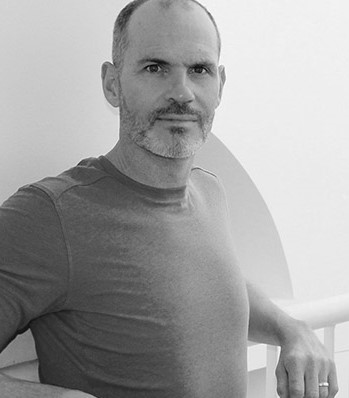 Matthew was my favorite teacher at SF State. He is known for being a hard but caring teacher, for his rigorous classes, and for expecting students to produce outstanding work. Matthew is not the teacher for the faint of heart—or for those who aren’t serious about their writing. Slackers usually drop his classes within the first couple of weeks, leaving a nice, solid core of serious writers. I loved his classes, and so did the rest of the students who stayed.
Matthew was my favorite teacher at SF State. He is known for being a hard but caring teacher, for his rigorous classes, and for expecting students to produce outstanding work. Matthew is not the teacher for the faint of heart—or for those who aren’t serious about their writing. Slackers usually drop his classes within the first couple of weeks, leaving a nice, solid core of serious writers. I loved his classes, and so did the rest of the students who stayed.
My favorite class was “The Craft of Writing: Characterization.” Matthew taught us how to make our characters sing, to be rounded and full. One of the best bits of writing advice he ever gave me is to give the antagonists good sides as well as bad. That’s such a logical, simple thing, but easy to forget: we want our bad guys to be bad. What we forget, however (without teachers like Matthew to remind us) is that characters that are all evil are flat, and stereotypical, and boring. Nobody wants to read about that guy. But when you add a tragic backstory, or a smidge of tenderness, or they kind way they treat old ladies, or, or, or…you end up with a character that won’t stay flat on the page. A character that leaps out and keeps the reader interested.
Matthew is not just good at teaching concepts like this, he’s also adept at infusing them into his fiction, as is evidenced in his new novel.
Doubting Thomas
Before I get into how beautifully Matthew draws his characters, let me give you an idea of the plot:
The first major scene of the story takes place in the recreation building of an upscale private school in Portland, Oregon. It is late May 2013. For twelve years Thomas has been a much loved fourth grade teacher at Country Day School. On this day he’s there with his lawyer for a town-hall meeting with parents, administration, and law enforcement. Thomas has been wrongly accused of molesting one of his charges, a little boy named Toby. The Sheriff speaks, the D.A., the child’s psychologist. The investigation and pursuant testimony absolves Thomas, but the damage is done.
Thomas’s whole life has changed, but, to this point he had remained faithful, thinking this will all blow over, because, of course, he’s innocent, and all of these progressive parents have known him and loved him for years. He say’s of the accusing parents “The Jays aren’t vindictive, they’re confused.”
Unfortunately, being innocent doesn’t change the outcome. With a single lie Thomas has lost a career that was more calling than job. His good name disappears, as do friends and confidants. His best friend up until that point had been Mercy, the school’s principal, who ends up playing politics instead of choosing loyalty. Thomas receives a large settlement, but his lawyer tells him that he will never teach again.
And, as pages reveal one after another, this is not the first devastating loss Thomas has been through, nor will it be the last. We visit these losses, and learn what Thomas learns about life along the way throughout the novel.
What I loved
Oh, so much! From lines like “The day smelled of beer, and cigarettes, and the first bloom of Jasmine;” (How lovely is that?) To showing us beautifully atmospheric setting: “Her office sparkled. All glass and wood, surrounded by Country Day’s near-choking foliage, wet and green, the drops on the glass and the glass itself created tiny prisms that fractured light from the early morning sun;” (yeah, another thing Matthew taught us to use: concrete details!) Then there are the lovingly drawn characters, such as Mercy:
She’d looked much younger in person than in the photograph on the website. In person she wore glasses, and her hair looked natural with caramel-tinted highlights along the tops and ends, which added even more dimension to her face with its soft angles and rounded lines except for the sharpness of her cheekbones. Her gestures, like using the muscles around her nose to move her glasses higher on it’s bridge so she could continue to use both hands for papers, revealed a nerdiness that endeared her to Thomas because he recognized them in himself and other teachers. On the websites photo she’d worn contacts and sported a wig…a style Thomas associated with Diahann Carrol, perhaps because, in person Mercy’s features had also reminded Thomas of the actress, even if her body language did not. Both had arched brows and wide brown eyes.
What I love so much about this paragraph is how it not only shows us what Mercy looks like—Diahann Carroll, lucky woman—but also shows us who she is, with the nerdiness and the glasses and the wrinkles of her nose.
Oh, and by the way, all three of these examples are in the first chapter. My mentor delivers!
But wait, there’s more.
The Social Commentary
This novel is set smack dab in the middle of Obama’s time in office, 2012-2015. This was, if you remember, a time in which we liberals thought we were living in a “post” society: Post-racist, post-sexist, post-homophobic. We hadn’t quite gotten to post-economic inequality, but we felt we were headed in that direction.
But, of course, this was also a time of push-back: Proposition 8, the California amendment against same-sex marriage was voted in, only to be overturned in both California courts and by SCOTUS. Bakeries were refusing to make wedding cakes for same-sex couples, and—SHOCKER—we not only had a Democratic president, but he was a black man to boot! The liberal paradise that we thought we were finally attaining was not to be (at least not then).
Matthew deals with these issues well in his fiction:
Push-back and Homophobia
In Chapter 3, Thomas meets his brother James at the Colorado Springs Airport. James greets his brother in what Thomas calls his “Look-at-me-I-have-a-gay-brother bit.” In other words, James loudly calls Thomas “Homo” and “faggot.” This garners the attention of a military man, who warns Thomas that he and his “boyfriend” need to watch their behavior around his kids. James wants to go after the guy, but Thomas, who is aware of the realities of life as a gay man, reminds him that people in this area carry guns, “assault rifles.” James calls Thomas paranoid and talks about a black president, and gays on TV, which Thomas shuts down brilliantly: “Don’t you get it?….What always comes after progress? Backlash and revenge.”
I think we can look at the last four years in this country as validation of that sentiment.
A Black Man’s Perspective
One of my favorite characters in this book is Reggie, Thomas’s brother-in-law. Not only is he as lovingly drawn as Mercy, he has a lot of very wise things to say. Things that—back to my original point—show the reader the depth and complexity of who he is. Early on we learn that Reggie is charming and opinionated-but-engaging. He seems nice, and he seems kind. Later, however, towards the end of the book is where we find out who the man is. It’s then that we learn what he thinks and feels.
We learn that Reggie is, above all else, a realist. He sees the world clearly, with no haziness regarding subtext and *ifs.* Reggie tells Thomas that cops hate him—a black man—first, then other brown people, then gay people like Thomas. He also states that he knows Thomas did NOT molest the boy at school because “Openly gay men do not molest fourth graders,” but continues on to talk about how the judgement of Thomas as a gay molester is there to say, as are the issues he has as a black man. (There are also some fairly amusing and pretty much on point mini-rants about the state of gay and black men in this country.)(I’m going to leave it to you to read those. They’re worth it.)
In getting to the crux of the conversation, Reggie echoes what Thomas said to James at the airport:
Liberals think that we’re post-race now because of Obama—and there are things to appreciate about him—but no single individual is a savior. His cabinet is made up of people for whom the system worked. Few of the people who were truly suffering before. And they’re suffering less now…I don’t want to run for office either, so I need to quit criticizing. Mark my words, though. Almost every African American and homosexual I know thinks we’re in a moment of progress. But you watch. There will be backlash, my friend.
Remember what I said about the last four years? Yeah.
But Honestly…
…this book isn’t all about the ills of society. In fact, it’s most about family, and resilience, and love. It’s about picking up the pieces when life throws you a year or three of disaster after disaster, heartbreak after heartbreak. In the end, Thomas has turned his life around, forging a new and happy existence. One of my favorite kinds of stories.
Doubting Thomas is set to be released on June 8th. You can find out more about Matthew here.
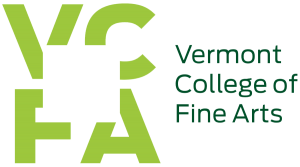


 The evening was led by James, the author of the bestselling novel The Kept, a finalist for the New England Book Award. I know I always rave about our teachers here at VCFA, but I must sing James’s praises as well. We’ve just finished his three-week class on structure, and I feel like my writing toolbox is fuller than it has ever been. Hearing his take on rising action and learning about Inner Story/Outer Story will serve me well in my future writing career. If you ever get a chance to take a class or workshop taught by James—whether here at VCFA or elsewhere—take the class. I promise you it will be worth it.
The evening was led by James, the author of the bestselling novel The Kept, a finalist for the New England Book Award. I know I always rave about our teachers here at VCFA, but I must sing James’s praises as well. We’ve just finished his three-week class on structure, and I feel like my writing toolbox is fuller than it has ever been. Hearing his take on rising action and learning about Inner Story/Outer Story will serve me well in my future writing career. If you ever get a chance to take a class or workshop taught by James—whether here at VCFA or elsewhere—take the class. I promise you it will be worth it.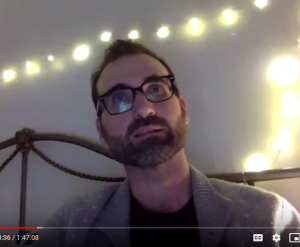 seminar and various modules. His poetry collection Mad River was published in 2017, and his chapbook 20,000 Pigeons was published in 2014. His cross-genre work has appeared in The New England Review, Ploughshares, The Rumpus, and Best American Short Stories of 2015. He is a co-founder and co-editor of Waxwing.
seminar and various modules. His poetry collection Mad River was published in 2017, and his chapbook 20,000 Pigeons was published in 2014. His cross-genre work has appeared in The New England Review, Ploughshares, The Rumpus, and Best American Short Stories of 2015. He is a co-founder and co-editor of Waxwing.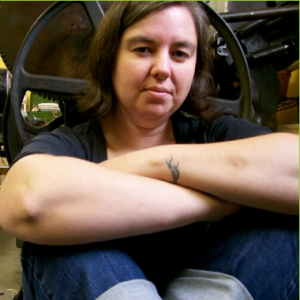 . Kelly is described on the VCFA website as a poet who “walked into a printshop and never looked back.” As visiting faculty, she teaches letterpress printing. She runs May Day Studios right here in Montpelier. Before falling for the smell of ink and paper, Kelly got her MFA in Creative Writing at California College of the Arts. (Truth be told, that’s where she succumbed to her love of letterpress.) She read us poetry from back in the day and beyond.
. Kelly is described on the VCFA website as a poet who “walked into a printshop and never looked back.” As visiting faculty, she teaches letterpress printing. She runs May Day Studios right here in Montpelier. Before falling for the smell of ink and paper, Kelly got her MFA in Creative Writing at California College of the Arts. (Truth be told, that’s where she succumbed to her love of letterpress.) She read us poetry from back in the day and beyond.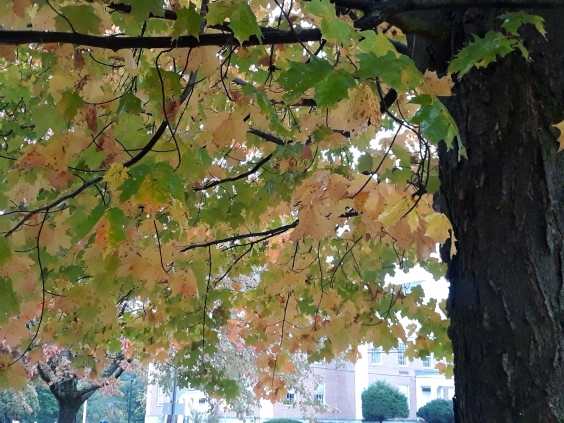
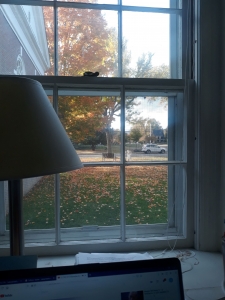 a New England Autumn, with oranges and reds mixing with green in the trees and on the grass. I think back to last year at this time, as I was just entering my second month in Vermont. Everyone warned me that we probably wouldn’t get much of a show, leaf wise, since the weather had been so “mild” for the season. When I say mild, I mean that it was 71 degrees with about a million percent humidity—or maybe it just felt like a million percent to a Californian used to dry weather. No. Even the students from the South were affectionately calling the Glover dorms “sauna.” We joked about having a luau, wearing Hawaiian shirts, and drinking cocktails decked with bits of pineapple.
a New England Autumn, with oranges and reds mixing with green in the trees and on the grass. I think back to last year at this time, as I was just entering my second month in Vermont. Everyone warned me that we probably wouldn’t get much of a show, leaf wise, since the weather had been so “mild” for the season. When I say mild, I mean that it was 71 degrees with about a million percent humidity—or maybe it just felt like a million percent to a Californian used to dry weather. No. Even the students from the South were affectionately calling the Glover dorms “sauna.” We joked about having a luau, wearing Hawaiian shirts, and drinking cocktails decked with bits of pineapple.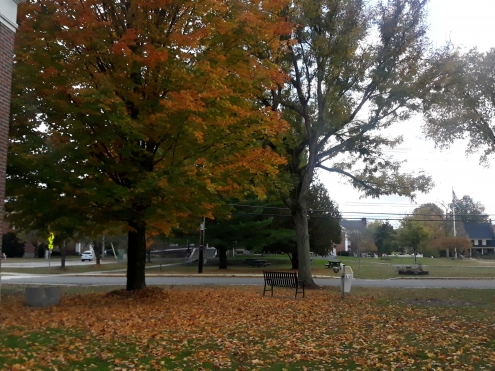
 Rita read to us from her memoir about how women keep their cool against social, sexual, and economic pressure. In a chapter titled “Cool As Kin,” Rita tells us about her family members who inspired her to be a writer and a creative. “From my great uncle I first learned about curiosity and what it meant to see the world through the eyes of an artist. His paintings were inspired by the idea of nature in meditation.”
Rita read to us from her memoir about how women keep their cool against social, sexual, and economic pressure. In a chapter titled “Cool As Kin,” Rita tells us about her family members who inspired her to be a writer and a creative. “From my great uncle I first learned about curiosity and what it meant to see the world through the eyes of an artist. His paintings were inspired by the idea of nature in meditation.”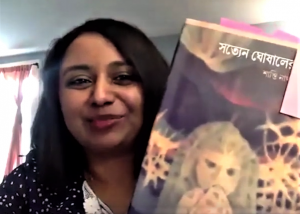
 Rita’s writing is as lush and beautiful as her uncle’s painting, with prose that reads like poetry, sounding at times like a waterfall skipping over stones. You can’t help but follow her story as it flows along. There is an especially evocative section as she describes a shadowbox tableau in her uncle’s house that shows a depiction of village life in ancient China. You can hear it from 00:12:17 to 00:14:10 on the video.
Rita’s writing is as lush and beautiful as her uncle’s painting, with prose that reads like poetry, sounding at times like a waterfall skipping over stones. You can’t help but follow her story as it flows along. There is an especially evocative section as she describes a shadowbox tableau in her uncle’s house that shows a depiction of village life in ancient China. You can hear it from 00:12:17 to 00:14:10 on the video.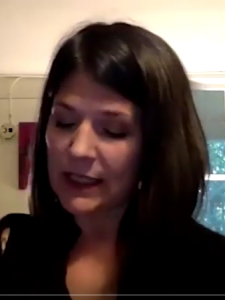 founder of the magazine Waxwing, and, of course, teaches here at VCFA. Erin told us that her tactic for picking what to read was to go with the piece that scared her the most to share, and she then read the first half of the first chapter of her novel in progress The Keener.
founder of the magazine Waxwing, and, of course, teaches here at VCFA. Erin told us that her tactic for picking what to read was to go with the piece that scared her the most to share, and she then read the first half of the first chapter of her novel in progress The Keener.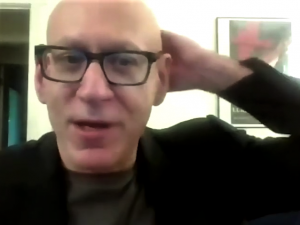 David read to us from his soon-to-be-published book The Very Last Interview, a compilation of some 2,700 questions that he’s been asked in interviews over the past 40 or so years. Not his answers, mind you, of which he said he has no interest, but the questions. He’s “fascinated by the aggressiveness” of these questions. He’s not kidding. These are some of the rudest, most pompous and arrogant questions to ever escape the mind, mouth, or pen of an interviewer. David views these as humorous. I can see the humor in them, BUT…if they were asked of me I’m sure I would’ve had to spend some time as a puddle-of-sad on the floor, or on a mountaintop flinging lightening bolts before I ever thought of laughing. Kudos to David for having a thicker skin!
David read to us from his soon-to-be-published book The Very Last Interview, a compilation of some 2,700 questions that he’s been asked in interviews over the past 40 or so years. Not his answers, mind you, of which he said he has no interest, but the questions. He’s “fascinated by the aggressiveness” of these questions. He’s not kidding. These are some of the rudest, most pompous and arrogant questions to ever escape the mind, mouth, or pen of an interviewer. David views these as humorous. I can see the humor in them, BUT…if they were asked of me I’m sure I would’ve had to spend some time as a puddle-of-sad on the floor, or on a mountaintop flinging lightening bolts before I ever thought of laughing. Kudos to David for having a thicker skin!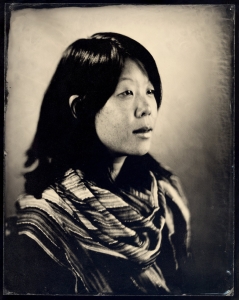 We welcome
We welcome 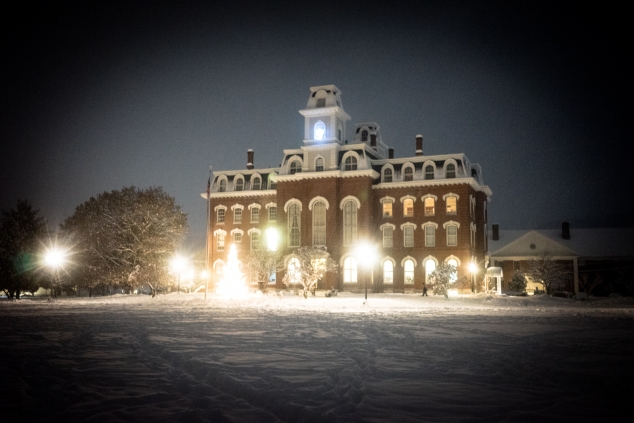

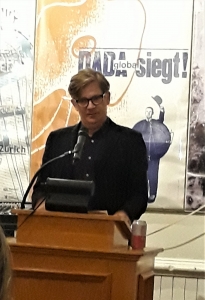 recipient of many awards, including a Pen award for editing. He’s been the judge of many other awards, contests and fellowships.
recipient of many awards, including a Pen award for editing. He’s been the judge of many other awards, contests and fellowships.
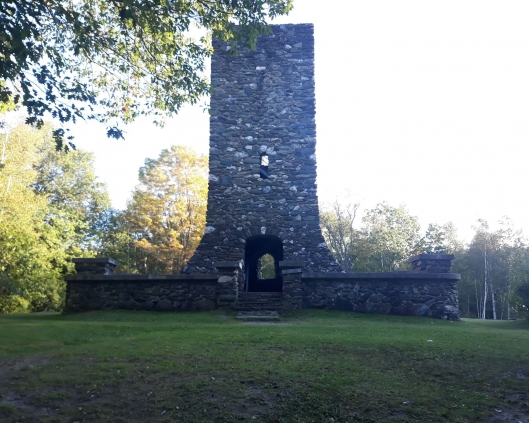
 I’ll probably always start these posts with something about the beauty of Vermont, and what a special place
I’ll probably always start these posts with something about the beauty of Vermont, and what a special place  hang on the bottom branches of skeleton forms. Other leaves have just started the jettison process. When people and dogs walk through the fallen leaf-litter they make soft crunching and shooshing sounds, an early reminder of the near-inaudible underfoot crunch of the snow that’s yet to come. The locals tell me that the Fall colors haven’t been as outstanding as in previous years, due to having a drier than normal September, but the leaves have been vibrant enough to make this California girl’s heart go pitter-pat.
hang on the bottom branches of skeleton forms. Other leaves have just started the jettison process. When people and dogs walk through the fallen leaf-litter they make soft crunching and shooshing sounds, an early reminder of the near-inaudible underfoot crunch of the snow that’s yet to come. The locals tell me that the Fall colors haven’t been as outstanding as in previous years, due to having a drier than normal September, but the leaves have been vibrant enough to make this California girl’s heart go pitter-pat.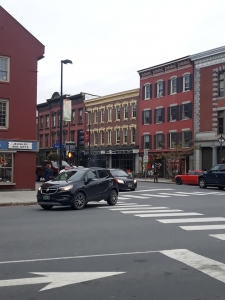 California and Vermont have many similarities: stunning vistas, sophisticated cities with lots of liberal, artsy folks. Cities in Vermont are smaller, of course. Montpelier, for example, is the nation’s smallest state capital, with nearly eight-thousand people. Eight-thousand people would be a town in California, not a city. There’s no doubt, however that Montpelier is a city. It’s downtown area bustles during the day, with locals, those with business at the Statehouse, and tourists.
California and Vermont have many similarities: stunning vistas, sophisticated cities with lots of liberal, artsy folks. Cities in Vermont are smaller, of course. Montpelier, for example, is the nation’s smallest state capital, with nearly eight-thousand people. Eight-thousand people would be a town in California, not a city. There’s no doubt, however that Montpelier is a city. It’s downtown area bustles during the day, with locals, those with business at the Statehouse, and tourists. 
 This easy hike begins just steps outside of the back door of the Glover dorms and takes you through a grassy area called
This easy hike begins just steps outside of the back door of the Glover dorms and takes you through a grassy area called 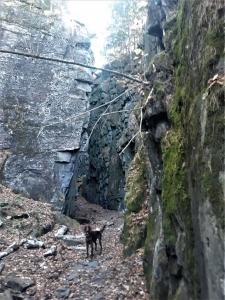 recent tagging it has an ancient or otherworldly feel, with slate walls forming a tall and narrow canyon. It’s quiet and peaceful, and a great place to meditate, or write, or even just sit. It feels as though there’s no one around for a hundred miles, and yet…you can be back downtown in less than a half an hour!
recent tagging it has an ancient or otherworldly feel, with slate walls forming a tall and narrow canyon. It’s quiet and peaceful, and a great place to meditate, or write, or even just sit. It feels as though there’s no one around for a hundred miles, and yet…you can be back downtown in less than a half an hour! There’s also
There’s also 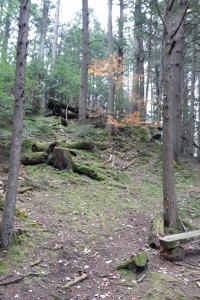 Register of Historic Places.) The park was established in 1899 with the bequeathing of its original 134 acres. The tower sits on land that was deeded to the city in 1911, at the very summit of Capitol Hill. Not only could you see all around the countryside from that summit, the tower stood out like a beacon to those downtown and at the Capitol Building. The hope was that seeing the tower on the hill would draw visitors up to the park.That worked until 1961 when the pines planted on the previously clear-cut pastureland grew tall enough to block the view.
Register of Historic Places.) The park was established in 1899 with the bequeathing of its original 134 acres. The tower sits on land that was deeded to the city in 1911, at the very summit of Capitol Hill. Not only could you see all around the countryside from that summit, the tower stood out like a beacon to those downtown and at the Capitol Building. The hope was that seeing the tower on the hill would draw visitors up to the park.That worked until 1961 when the pines planted on the previously clear-cut pastureland grew tall enough to block the view.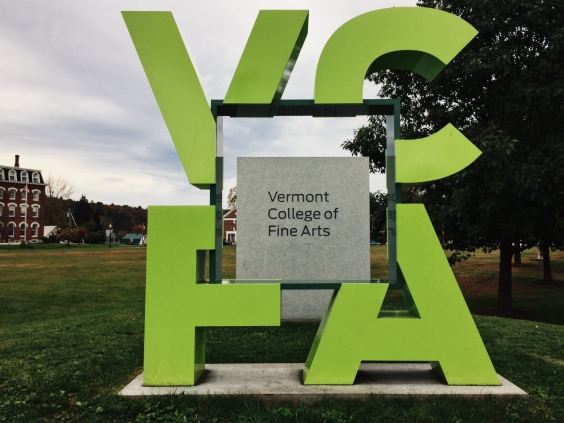
 The leaves have started to change: a spot of scarlet here and there, a clump of crimson among a sea of green. Last week and the week before it was pure green with no red to mark the change. Now, however, the crimson grows with each day while the green, like the sea, recedes. I’m looking forward to the New England color show, as are my fellow out of state students. We come from across the country and across the world, with two from California, two from Oregon (one of them by way of North Carolina), two students from the South (Virginia and Georgia), one from the rust belt state of Pennsylvania, another from Massachusetts, from neighboring counties, and from as far away as Nigeria. We’re a diverse bunch, just getting used to Montpelier, to the dorms and the school, and we are beginning to form friendships with fellow writers that could last for the rest of our lives.
The leaves have started to change: a spot of scarlet here and there, a clump of crimson among a sea of green. Last week and the week before it was pure green with no red to mark the change. Now, however, the crimson grows with each day while the green, like the sea, recedes. I’m looking forward to the New England color show, as are my fellow out of state students. We come from across the country and across the world, with two from California, two from Oregon (one of them by way of North Carolina), two students from the South (Virginia and Georgia), one from the rust belt state of Pennsylvania, another from Massachusetts, from neighboring counties, and from as far away as Nigeria. We’re a diverse bunch, just getting used to Montpelier, to the dorms and the school, and we are beginning to form friendships with fellow writers that could last for the rest of our lives.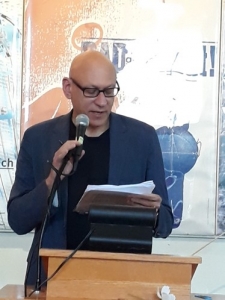
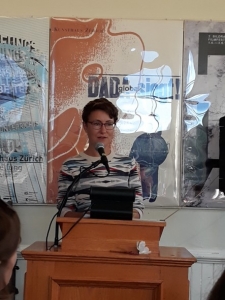
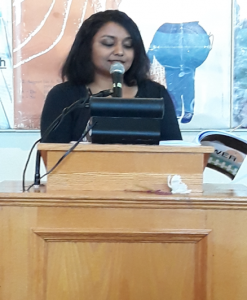 fall on that fateful day. Quite a compelling way to spend the eighteenth anniversary of that event.
fall on that fateful day. Quite a compelling way to spend the eighteenth anniversary of that event.